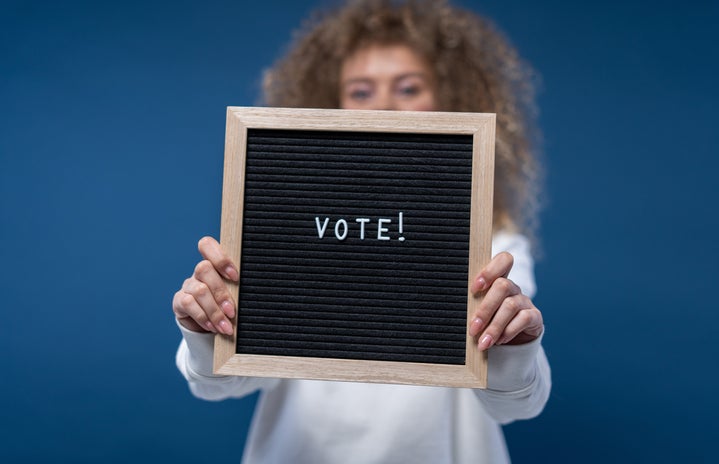Women will be responsible for any drastic progress over the next century in, arguably fractured, American politics. A sweeping claim, I know, but I truly believe that the only manner by which meaningful change will be brought about is with greater female influence in places where decisions are made (more on this later). As a young woman/eligible voter, it is disheartening to see man after man on major political tickets, and the lack of diversity is even more unsettling. On November 3rd, the 2020 presidential election will officially commence, although it is already in full swing, as nearly 30 million absentee ballots have been sent and received. That staggering number of early voters says one thing: we’re tired. The perpetual lying is exhausting, the injustice people of color are facing is distressing, women are still facing economic inequality and a lack of equal opportunity, and the COVID-19 pandemic that has consumed our lives for the past eight months, and will continue to leave devastation in its wake for the foreseeable future, is excruciating. However, our injured country can be healed, and female influence will be the metamorphosing factor.
Let’s talk about voter turnout history. Women were given the constitutional right to vote 100 years ago, and we have typically had a slightly higher voter turnout than men. According to a Pew Research survey, 4% more women have voted in presidential elections than men. That same survey shows that there has been an 8% increase in women leaning towards the Democratic Party since 1984, and a 4% decrease in women siding with the Republican party. The tendencies for women to lean left and men to lean right has been burgeoning since the Reagan era, and the 2016 presidential election was a catalyst for an even more pronounced migration in women’s party identification and voter turnout. Now, time for some data on women from CNN Exit Polls:
- 55% preferred Barack Obama over Mitt Romney in 2012
- 59% chose Democratic congressional candidates in the 2018 midterm elections
- Party identification shifted from 48% Democratic/ 42% Republican in 1994 to 56% Democratic/ 37% Republican in 2017
Female voters of every race and demographic are trending towards the Democratic Party, particularly Millenials, and most recently, Gen Z–– the newest generation with some members eligible to vote. Now, what does this mean? Think about the historical characteristics of GOP leaders: white, middle-upper age bracket, wealthy, and male. These trends are showing that women just don’t think GOP candidates see the world the same way they do, and most of those candidates are not willing to fight for issues pertaining to women’s rights. In fact, in a recent Pew Research Survey (2019), 81% of men siding with the Republican Party believe that any barriers hindering the ability for women to get ahead are nonexistent. In contrast, 83% of women leaning towards the Democratic Party believe that women are still at a disadvantage. And it’s true, women are still viewed as lesser than men, and partisan ties aside, the notion that the majority of men in one particular party are incapable of seeing long-standing issues in relation to gender equality indicates the need for change, and it must happen quickly.
Think about the duties of our government. Since we vote our government officials into their positions of power, the government should work for us, representing us and our ideals at the highest level. But the fact is, the United States’ government has been overwhelmingly dominated by men, so, ask yourself, how are men supposed to take up the grievances of women if they don’t have first-hand experience with gender discrimination, reproductive rights, the fight to “break the glass ceiling”, sexual misconduct, etc.? Women of color, transgender women, and especially trans women of color are at an even more significant disadvantage, and face an even greater multiude of inequalities than cis women and white women do. So, why don’t we see LGBTQ+ women and women of color represented on all levels?
This isn’t to say progress isn’t being made, it’s certainly is, but ever so slowly. Representative Sharice Davids became the first openly LGBTQ Kansasn to be elected to Congress, and one of two Native Americans. The 2018 midterm elections were dubbed, the Year of the Woman–– Democratic women won 93 seats and Republican women won 13 seats. Democratic Representatives Rashida Tlaib and Ilhan Omar became the first Muslim women elected to Congress, Republican Senator, Marsha Blackburn, was the first female senator from Tennessee (yes, the FIRST), and Governor Kristi Noem became the first female governor of South Dakota, a state that is 131 years old. Are we satisfied with that? Are 96 House of Representative seats out of 435 enough? How about 23 out of 100 seats in the Senate? 9 governorships? The answer is simply, no.
We have a unique opportunity this presidential election to see the first female Vice President take office. Senator Kamala Harris of California is Vice President, Joe Biden’s, running mate against incumbent President Donald Trump and Vice President Mike Pence. We are at a turningpoint as a country. Record numbers of women are being elected to Congress and governorships, but why stop there? Isn’t it time to see a woman in the second highest position of power in our government, and, eventually, the Presidency? Women’s issues have long been deemed inferior and cast-aside in places where they should be bolstered. But think about who occupies the majority of positions of power: chiefly, men, who cannot personally understand the concerns of women. Late Justice Ruth Bader Ginsburg wisely said, “Women belong in all places where decisions are being made”, and it rings true, especially now, when our country’s future looks so bleak. However, it is time to break this cycle by electing women to office, and since we have a historically higher voter turnout than our male counterparts, let’s do it this election.



